ARM Cortex A12: Between Cortex A9 and A15 in Power & Perf, Sampling in Late 2014
by Anand Lal Shimpi on June 2, 2013 11:31 PM EST- Posted in
- Smartphones
- CPUs
- Arm
- Mobile
- Tablets
- Trade Shows
- SoCs
- Cortex A12
- Computex 2013
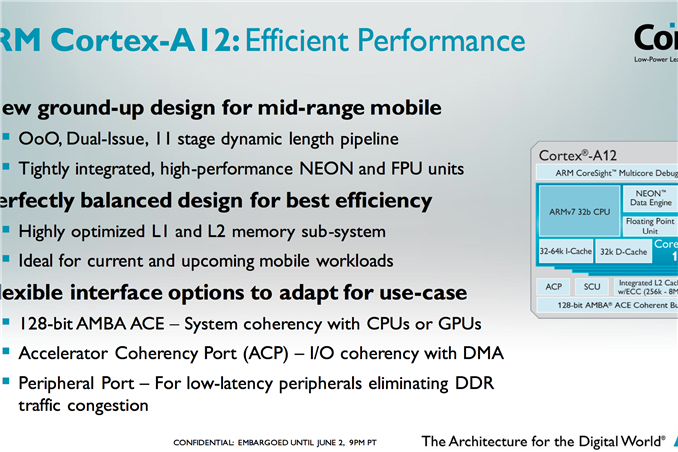
We’ve talked about the hole in ARM’s product lineup for quite a while now. The Cortex A9 is too slow to compete with the likes of Intel’s Atom and Qualcomm’s Krait 200/300 based SoCs. The Cortex A15 on the other hand outperforms both of those solutions, but at considerably higher power and die area requirements. The slide below from Samsung illustrates my point clearly:
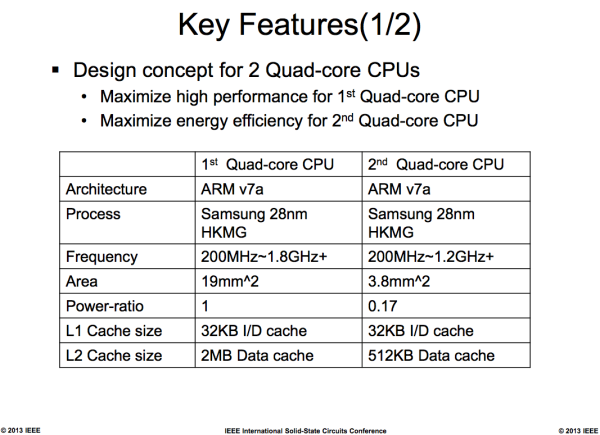
The comparison point here is the Cortex A15 and Cortex A7, but the latter should be quite performance competitive with a Cortex A9 so the comparison is still relevant. The Cortex A15 island in Samsung’s Exynos 5 Octa occupies 5x the die area as the A7 island, and consumes nearly 6x the power. In exchange for 5x the area and 6x the performance, the Cortex A15 offers under 4x the performance. It’s not exactly an area or power efficient solution, but a great option for anyone looking to push the performance envelope.
Today, ARM is addressing that hole with the Cortex A12.
This announcement isn’t a deep architectural disclosure, but we do have some high level details to share. Like AMD’s Jaguar, Intel’s Silvermont and even ARM’s A9, the Cortex A12 is a dual-issue out-of-order architecture. Unlike the Cortex A9, the Cortex A12 is fully out-of-order including the NEON/FP units (NEON/FP was in-order on Cortex A9).
Pipeline length increased a bit compared to Cortex A9 (11 stages), however ARM told me to expect similar frequencies to what we have with the Cortex A9.
The execution back end has also been improved, although I don’t have many details as to how. My guess is we should expect something a bit wider than Cortex A9 but not nearly as wide as Cortex A15.
Memory performance is much improved compared to Cortex A9 as well, which we’ve already demonstrated as a significant weak point in the A9 architecture.
All of the architectural enhancements are supposed to provide up to a 40% increase in performance (IPC) over Cortex A9 at the same frequency and process node. ARM isn’t talking power, other than to say that it can do the same workload at the same power as a Cortex A9. In order words, Cortex A12 should have higher power than Cortex A9 but faster execution reduces total energy consumed. With a higher max power we’ll see more dynamic range in power consumption, but just not nearly as much as with the Cortex A15.
Cortex A12 also adds support for 40-bit memory addressability, an intermediate solution before we get to 64-bit ARMv8 based architectures. Finally, Cortex A12 features the same ACE bus interface as Cortex A7/A15 and can thus be used in big.LITTLE configurations with either core (but likely exclusively with the A7s). Given the lower power profile of Cortex A12, I'm not sure the complexity of doing a big.LITTLE implementation will be worth it though.
ARM expects the Cortex A12 to be used in mainstream smartphones and tablets where cost and power consumption are a bit more important. The design makes a lot of sense, the only downside is its launch timeframe. ARM expects to be sampling Cortex A12 in late 2014 with the first devices showing up in 2015. Update: ARM clarified that SoCs based on Cortex A12 would be shipping to device vendors in mid-2014, with devices shipping to consumers by late 2014 to early 2015. ARM has optimized Cortex A12 processor packs at both Global Foundries (28nm SLP) and TSMC (28nm HPM).


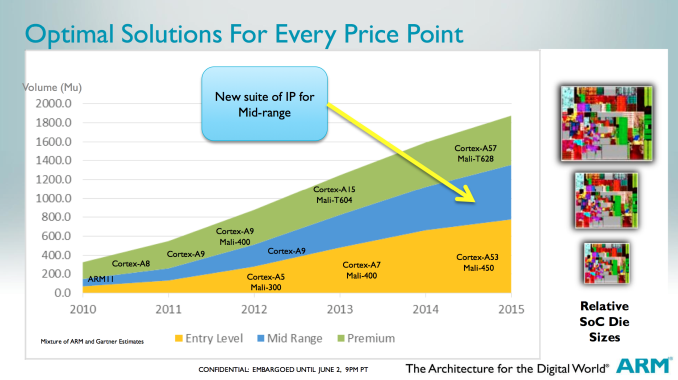
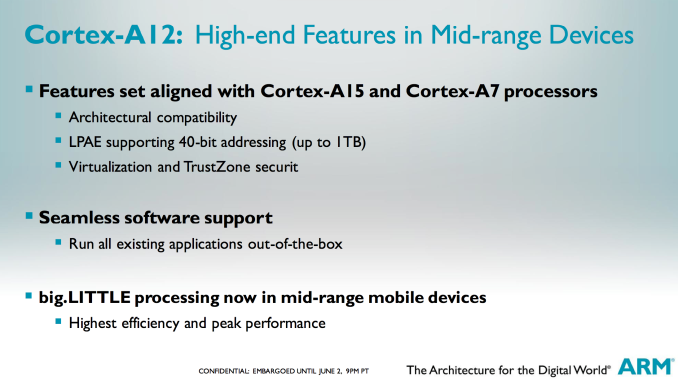
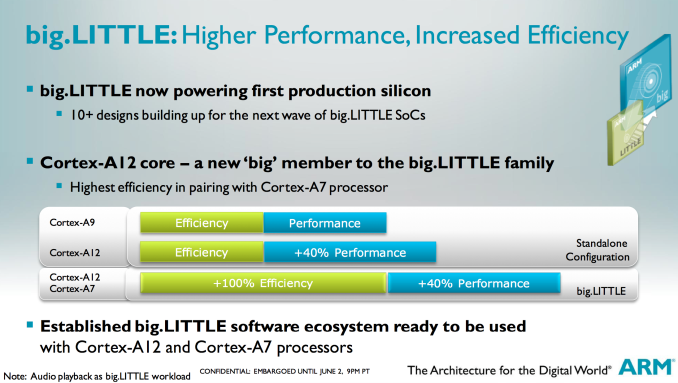








78 Comments
View All Comments
Wilco1 - Wednesday, June 5, 2013 - link
Yes Tegra 4i would have been a really great design if it were released last year, not later this year. I'm sure it will get more design wins than Tegra 3. However when A12 comes out there will be no reason at all to continue using A9, not even A9R4 simply because R12 beats it on power, performance and die size. That still leaves a window for Tegra 4i, but it is not going to last that long. If a Tegra 5i exists it will use A12, what other CPU do you think it would use???wsw1982 - Tuesday, June 4, 2013 - link
Your logic behind the A12 is planned before A15 on their number is not valid. In your logic, the A7 should planed before the A8... Hehe, the Xbox after Xbox 360 is... xbox one. If they planed the A12 long before the A15, what happened to ARM Engineering? Their design team had a 3 years delay (compare to A15). If this was true, ARM should be worried more :)And as I said the A15 is not same class core as Krait/Swift, the A12 is. And when A15/Krait/swift come to 20nm, why cannot A9? The gap should be the same. As I said, the only logic reason is ARM made a wrong decision and cause them the problem now (The invasion of ATOM).
As for 20nm, you know, TSMC said they would ready the the 28nm production during Q2,2010 in 2009. And the first 28nm mobile chip came in 2012. So good luck with the expectation:)
Wilco1 - Tuesday, June 4, 2013 - link
You're very confused. What I'm saying is that the number used in Cortex cores indicates relative performance. The gap beween A9 and A15 means that there has been space reserved for a CPU that fits in the middle - the A12. That doesn't imply at all that the design of A12 started before A15, just that a successor of the A9 was planned a long time ago.No, A15, Krait and Swift are the same class: 3-way fairly aggressive OoO cores. A9, A12 and Silvermont are 2-way, limited OoO and thus in the same class. Silverthorne and Cortex-A8 are both 2-way in-order so in the same class.
It looks like TSMC has learned from 28nm debacle so I don't expect 20nm will be as troublesome. They seem to have invested a lot more effort into it than before.
The A9 is old and obsolete, so it cannot compete - even at 20nm: the A7 is almost as fast and far more efficient, so why would anyone use A9? Given that A9 will disappear, the gap between A7 and A15 will only increase on 20nm, so there is a need for something to fill it.
wsw1982 - Tuesday, June 4, 2013 - link
The 3-way isn't the only parameter to affect the design, the ATOM use in-order design, which didn't make it the same level chip as original pentieum.The core is more or less a black box to outside world, which is only differentiated by it's performance and power consumption. And in this case, the A15 is 2 times more powerful and > 2times power hungery than A9. The Atom, krait and swift is under same power envelop as A9 (but of couse the performance gain is not free, they are little bit more power hungry than A9). And from a performance and power consumption point of view, the A12 is at the same catalog as krait, swift and current gen Atom.
The A7 is actually worse than/comparable to A8 in a performance point of view, but with better power efficiency and less area.
http://www.anandtech.com/show/4991/arms-cortex-a7-...
You are right about the A12 that it design to replace the A9. However, the ARM, to me, should plan the A12 last years instead of A15. There was nothing exist for ARM to compete with Atom, Krait and swift on the market until the end the 2014. And the A15 is clearly targeting a non exist market, that only the throttled-down version of it exist on limited designs. On the other hand, the krait and Atom are eating ARM's cake.
Maybe you are right the A15 could be fine under 20nm technologies. But this is also means ARM designed and introduced some product in 2012 which can only be useful after 2014 (very optimistic for TSMC's 20nm technology). On the mean while give up the market from 2012 to 2014 to ATOM, krait and swift and simply because it had no valid product. Doesn't it sound like problem?
Wilco1 - Tuesday, June 4, 2013 - link
You can't classify CPUs just by power consumption/frequency. For example Swift is only low power because it is run at a low frequency. Clock an A15 at 1GHz, and it would equal Swift on performance while using similar or less lower power than Swift. Similarly Krait is pretty efficient around 1.5GHz but uses a lot more power when trying to keep up with A15 at ~2GHz.Claiming ARM has no valid product for the next 2 years is ridiculous. I really don't see the huge problem you are imagining. A15 is ARM's flagship and it is clearly able to compete with Swift, Krait and Silvermont, so you'll see it in many devices including lots of phones. Yes, it would have been better if A12 was released a year earlier - A9 is really near the end of its life, however it isn't needed to replace A15.
TSMC's 20nm will be in production this year. Even if you are pessimistic about it and think they will be at least 12 months late, it means devices by mid 2014 or around the same time Silvermont will appear in mobiles.
wsw1982 - Monday, June 3, 2013 - link
The Exynos Octa run A7 at 1.8 GHz, and A15 maximum at 1.2 GHz. please check the anand review.Cow86 - Monday, June 3, 2013 - link
It was already said there, and updated by Anand, that it is the other way round. The A15 runs at a higher speed, which is much more logical (and you can find it in plenty of other sources online).I also think that the A12 is a great SoC...if it were available today. It seems to be shooting for the 'best of both worlds' route that Krait has currently taken, with both decent power consumption and performance. It'll just be woefully late to market...and I also can't help but think that the A53 will be very close to market as well presumably by the time this is out...Shouldn't be far below the A12 in performance either, yet maybe a fair bit more efficient (not to mention 64 bit) so it might render it obsolete already. We'll see.
wsw1982 - Monday, June 3, 2013 - link
But in this case, A15 runing at 1.8Ghz, it bascially means the A15 is slower than current gen. ATOM in IPC. It take four A15 cores running at 1.8Ghz to compete with 2 saltwel core running at 2Ghz or 4 krait core running at 1.9Ghz. ( The benchmark of S4 and Lenovo K900). And this is extreme Odd. Even the dual core A15 in nexus 10 can outperform the quad core A15 at 1.8GHz in lots of benchmark. Is that means, in the A15 case, the more cores the less performance?Wilco1 - Monday, June 3, 2013 - link
No, A15 is clearly much faster than Atom clock for clock (eg. check the link I posted), so I don't see how you can think Atom could possibly compete? Note some S4's use 1.6GHz A15, others use 1.8GHz A15, yet others use 1.9GHz Krait (confusing I know...). But where does it show dual A15 outperforming a quad A15???wsw1982 - Tuesday, June 4, 2013 - link
please!!! check the comparison between Galaxy S4 (octo) , Galaxy S4 (krait), Nexus 10 and Lenovo K900. I am talking about overall performance. You can find out the Quad-core A15 (octo) is barely faster than Dual-core Atom running at 2Ghz. The only possible reason for this is A15 running at 1.2 Ghz instead of 1.8Ghz, OTHERWISE, even running at 1.6Ghz, the A15 become slower than 5 years old Atom in IPC. Do you have any other logic explanation?